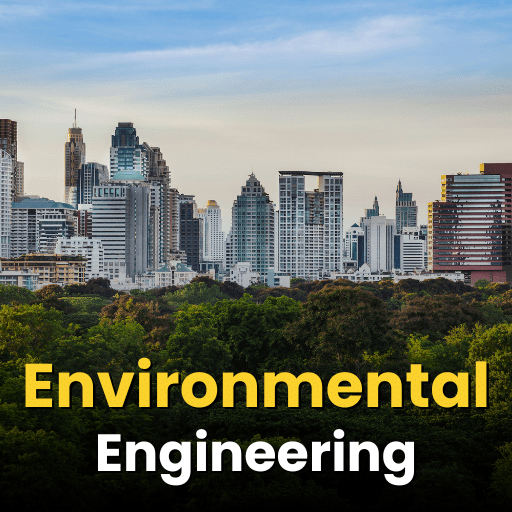A stimulus is anything that causes a living being to react. For example, if you touch something hot, you will quickly pull your hand away. This is your body’s way of responding to the heat. All living things react to stimuli, but the way they react and how fast they do it can be different for each one.
Living Creatures: Exploring their Characteristics Chapter Notes | Science Class 6 PDF Download
| Table of contents |

|
| What Makes Living Beings Special? |

|
| Essential Conditions for Germination of a Seed |

|
| Life Cycle of Plants |

|
| Life Cycle of Animals |

|
| Key Points |

|
What Makes Living Beings Special?
Living beings have key traits like the ability to move, eat, grow, breathe, excrete, respond to stimuli, reproduce, and die. If any of these traits are missing, the entity is not considered alive.
One sunny morning, Arjun was playing near a pond when he saw a small plant pushing through the soil, a butterfly flying, and fish swimming. He wondered, "Why do these things move and grow, but rocks and water don’t?"
His grandmother explained, "Living beings have special qualities that make them alive, like moving, eating, growing, and breathing. Fish, for example, take in oxygen from the water."
Excited to learn more, Arjun set out to discover what makes life so special. Are you ready to join him? Let's explore the world of living creatures!

What sets the Living things apart from the Non-Living?
- Living Things: Living things are beings that show traits like movement, growth, breathing, reproduction, and reacting to their surroundings. Examples include animals, plants, and humans. All living beings move, need food, and grow. They also breathe, reproduce, eliminate waste, react to stimuli, and eventually, die.
- Non-living Things: Non-living things are objects that do not have life. They do not show traits like growth, movement, breathing, nutrition, reproduction, or reactions to stimuli. Examples include rocks, water, and toys.

Do plants move from one place to another like animals?
No, plants do not move from one place to another like animals. However, they do exhibit certain movements, such as flowers opening and climbing plants wrapping around objects.
Different movements of plants
- Plants cannot move from one place to another, but they do exhibit various types of movements. For instance, insectivorous plants rely on insects for their nutrition, while climbers twist around nearby objects.
- Although plants do not move from place to place, they demonstrate different movements such as flowers opening, insect trapping in plants, etc. The opening of flowers is one such example of movement in plants.
- Another example of movement in plants can be seen in insectivorous plants.
- An example of an insectivorous plant is Drosera, which has saucer-shaped leaves covered in hair-like projections that are sticky at the ends. When an insect lands on the leaf, the hairs bend inward to trap it.
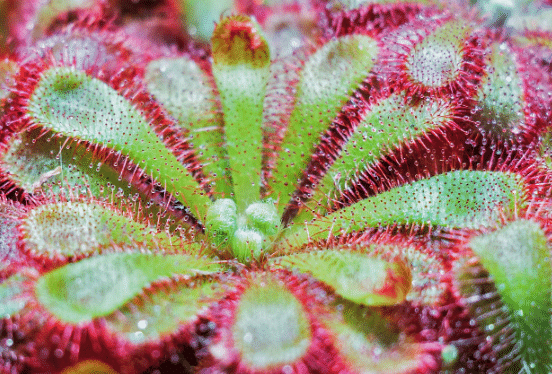
Growth and Nutrition in Living Beings
We can observe how a tiny plant develops into a big tree, as well as how animals grow and mature from young to adult. Every living organism goes through various stages in its life, and these growth processes are unique to each species. These changes are crucial for both plants and animals to survive and ensure the continuation of their species.
Growth
All living beings experience growth, which involves an increase in size, complexity, and development over time. For example, a small plant can become a large tree, and animals transform from juvenile to adult stages. We see transformations such as pupae turning into insects and tadpoles becoming frogs.
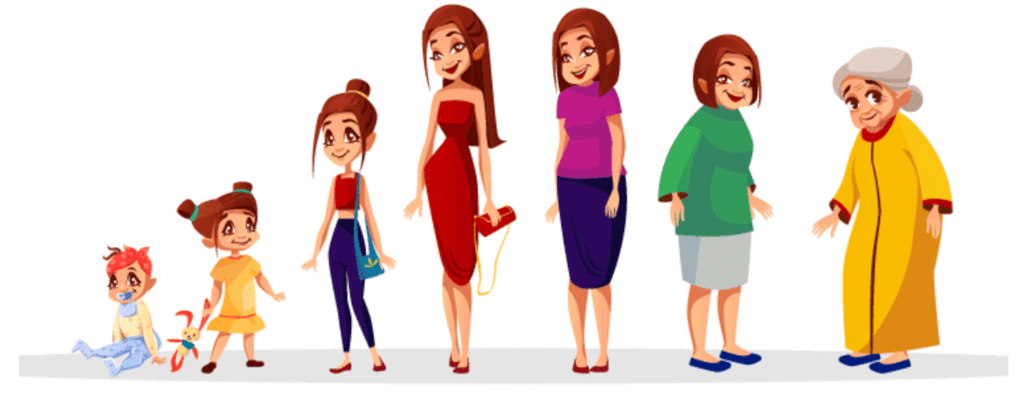
Nutrition
Living beings require food (nutrition) for their growth and development. Food supplies the energy needed for growth, repair, and the maintenance of bodily functions.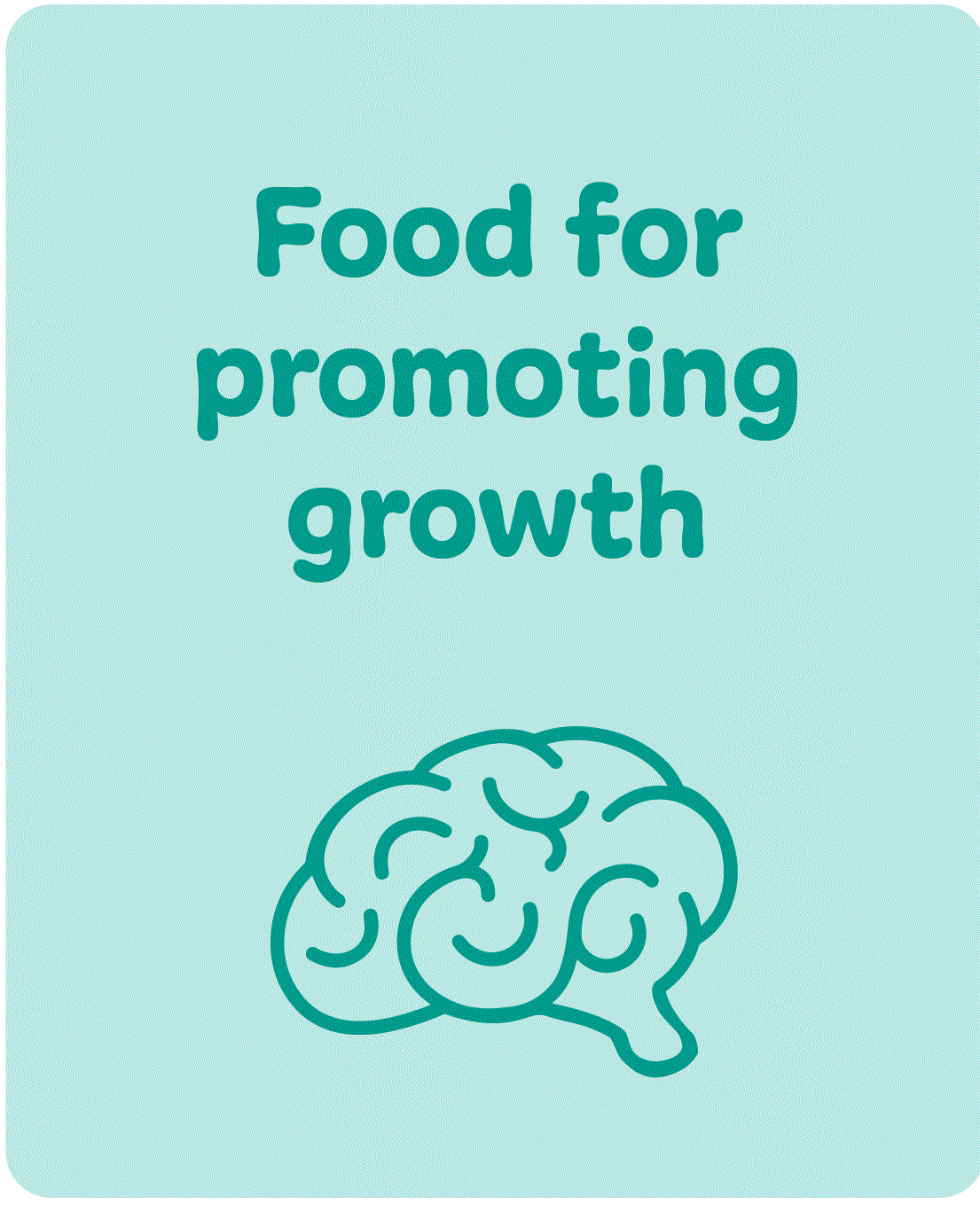
The key characteristics of living beings include movement, eating, growth, breathing, excretion, responding to stimuli, reproduction, and death. If any of these features are absent, it indicates that the organism is not alive.
Breathing and Respiration in Living Beings

- Breathing is when we take air into our bodies (inhaling) and then release it (exhaling).
- Respiration refers to the overall process of using the oxygen we inhale to create energy from the food we eat.
- Plants breathe through tiny openings known as stomata.
- All living organisms, including plants, animals, and microscopic creatures, need to respire to survive.
Excretion in Living Beings
- The process of getting rid of waste products from the body is called excretion.
- This is important to prevent harmful substances from accumulating in the body.
- All living beings excrete waste.
- Plants can also remove excess water and minerals, releasing them as small droplets on their leaves.
- In animals, urine is produced as part of the excretion process. It's interesting to note that plants also excrete!
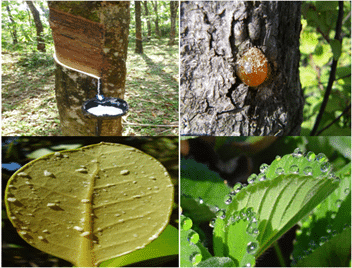
1. Excretion in Animals
- The act of removing waste from the body is called excretion.
- Animals get rid of waste using different organs, particularly their kidneys, which filter blood to take away excess water, salts, and other waste, creating urine.
- Urine is a key product of this waste elimination process in animals.
- Excretion is vital for keeping the internal balance of organisms.
2. Excretion in Plants
- While photosynthesis occurs, plants release oxygen as waste during the day and produce carbon dioxide during respiration.
- Plants also excrete gases through small openings known as stomata.
- You might see plants release extra water and minerals as tiny droplets on their leaves.
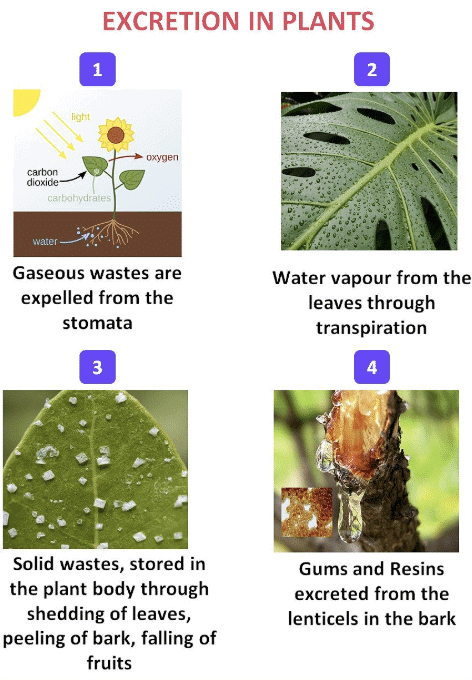
Response to Stimuli in Living Beings
Response to Stimuli
All living beings respond to changes around them, called stimuli. For example, the touch-me-not plant folds its leaves when touched. Some plants, like the amla tree, fold their leaves after sunset. You can try observing more such plants nearby that fold their leaves at night. Response to Stimuli in Living Beings
Response to Stimuli in Living Beings
Plant Responses
- Plants do respond to stimuli as well. For instance, touch-me-not (mimosa) plants close their leaves when touched.
- Some plants can even show how quickly they grow. For example, the leaves of certain plants, like the amla (Indian gooseberry) tree, tend to fold together.
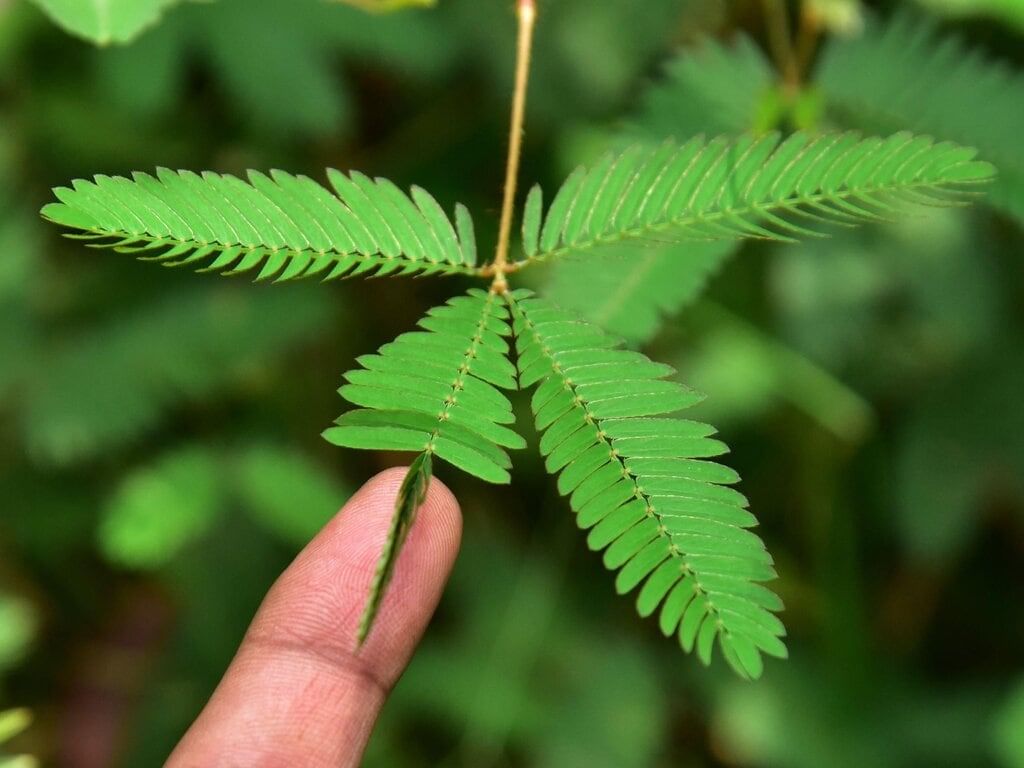
Reproduction in Living Beings
- Reproduction is essential for the survival of life. It is the way living organisms produce new members of their species.
- This process is vital for life to continue on Earth.
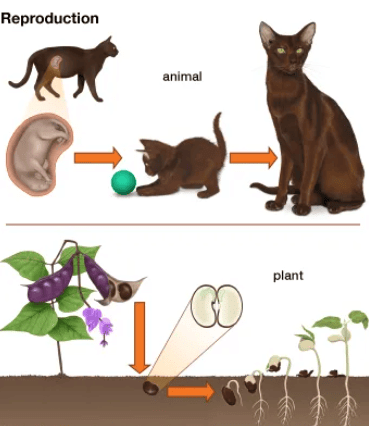 Reproduction in Living Beings
Reproduction in Living Beings
A living being is deemed dead when it can no longer show signs of life, such as movement, growth, or the need for food, even with access to resources like food, air, and water.
Essential Conditions for Germination of a Seed
Why is water important for seed germination?
Water is essential for germination as it activates the enzymes that initiate the growth process within the seed. It softens the seed coat and allows the tiny embryo to develop into a plant.
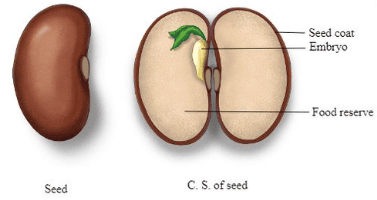
- Germination occurs when a seed transforms into a new plant under suitable conditions. It requires water, air, and the right environment to start the growth of the embryo.
- Essential Conditions: Water is necessary to activate growth enzymes. Air provides oxygen for respiration. Generally, most seeds do not need light for germination; however, sunlight is necessary for the seedling's continued growth after germination.
- Example: For bean seeds, germination needs the correct levels of water and air. The seed absorbs water, the seed coat splits open, and the radicle (young root) along with the plumule (young shoot) develops into a new plant.
 |
Download the notes
Chapter Notes: Living Creatures: Exploring their Characteristics
|
Download as PDF |
Required Conditions
- Water: Seeds need water to start growing. It helps the seeds perform the necessary actions for development. The outer layer of the seed is called the seed coat. Water softens this coat, allowing the tiny embryo inside to grow into a plant. It also starts the processes needed for growth.
- Air and Soil: Seeds require air for germination, which they get from the gaps in the soil. These gaps also help roots grow more easily.
- Light and Dark Conditions: For bean seeds, light is not needed for germination, and in general, most seeds do not require light at this early stage. However, after germination, sunlight is crucial for the seedling's further growth.
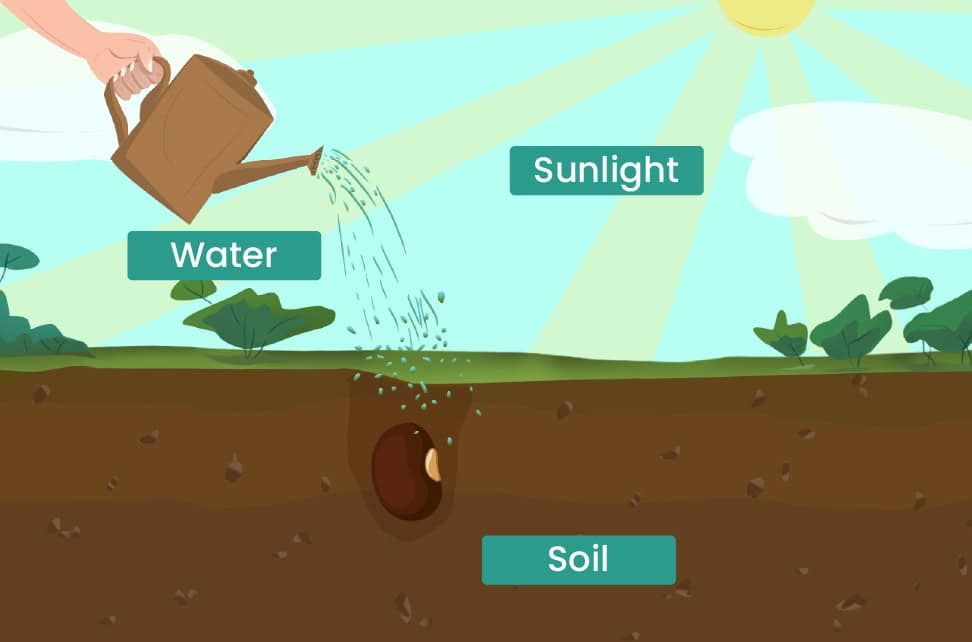
Do you know?
Some seeds of flowering plants, like Coleus and Petunia, require light to begin growing. If these seeds are covered with soil, it prevents them from sprouting. Conversely, seeds such as Calendula and Zinnia need darkness to germinate, so they should be buried with enough soil to block light.
Growth and Movement in Plants
- Upright Position: When a plant is upright, the root grows downwards, while the shoot grows upwards.
- Inverted Position: If a plant is turned upside down, the root bends and still grows downwards, and the shoot bends to grow upwards.
- Directional Sunlight: When a plant receives light from one direction, the shoot grows towards the light, while the root continues to grow downwards.

Life Cycle of Plants
- Seed Germination:. seed begins to grow into a young plant when the right conditions are met.
- Growth and Maturation: The young plant develops and matures, ultimately producing flowers and fruit. The fruit, in this case a pod, holds seeds that will create a new generation of bean plants.
- Seed Production: The journey from seed to plant and then back to seeds is referred to as the life cycle of a plant.
- Life Cycle Process: This entire path from seed to plant and back to seeds is known as the life cycle of a plant.
- Plant Death: When a plant ceases to grow and all life functions gradually stop, even when conditions are still suitable, the plant is considered dead.
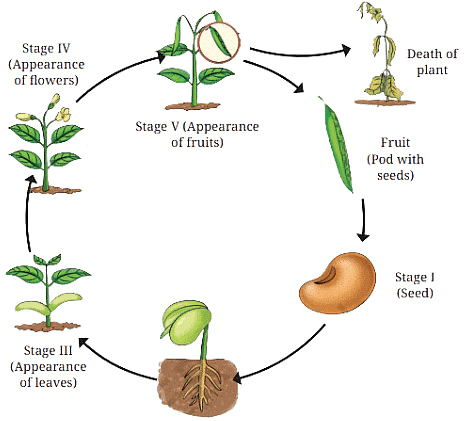
Life Cycle of Animals
Do all animals have the same life cycle?
No, different animals have different life cycles. Some animals undergo metamorphosis, like butterflies, while others, like humans, have a more direct development.
Life Cycle of a Mosquito
Mosquitoes experience four stages in their life cycle: egg, larva, pupa, and adult. This cycle starts with a newborn and includes various stages of growth and development, leading to the adult stage and ultimately death.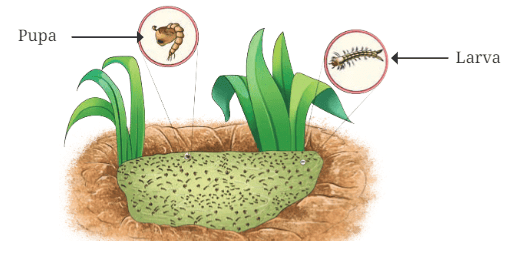
Stages:
- Egg: Laid on or near water.
- Larva: Lives in water, feeds on organic matter.
- Pupa: A resting stage, does not eat.
- Adult: Emerges from the pupa, can fly and reproduce.
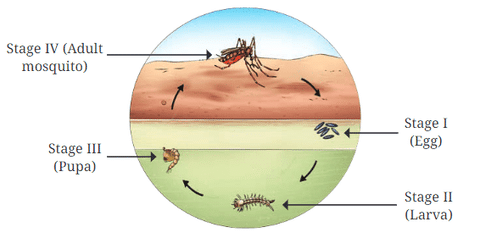 Life Cycle of a Mosquito
Life Cycle of a Mosquito - The adult mosquito that comes from the pupa rests on the water's surface for a short time before flying off. Adult mosquitoes can live for about 10 to 15 days.
- A mosquito's life starts as an egg (stage I), which turns into a larva (stage II), then into a pupa (stage III), and finally becomes an adult mosquito (stage IV).
- The female mosquito lays eggs on or near water, continuing the cycle.
- During the different life stages, there are clear changes in appearance and body shape. The egg looks very different from the larva; the larva is distinct from the pupa, and the pupa is unlike the adult mosquito.
Do you Know
- The silk moth goes through four stages in its life cycle: egg, larva, pupa, and adult.
- Eggs hatch into larvae, which grow in size. As they grow, larvae produce a thread-like material that they wrap around themselves. This process leads to the formation of pupae.
- The thread-like material secreted by the larvae is used to make silk fabric.
- In India, the Khadi and Village Industries Commission (KVIC) has established several centers to support silk production.
Life Cycle of a Frog
Frogs go through a unique life cycle that includes several stages: the egg stage, embryo stage, tadpole stage, froglet stage, and adult frog stage. Each stage involves major transformations in their shape and living environment as they shift from water to land.
- Egg: Laid in water, typically in groups.
- Embryo: The stage where the egg develops into an embryo.
- Tadpole Stage: Early tadpoles have tails and no legs; later ones develop hind legs.
- Froglet: They still inhabit water but start to explore land, growing and losing their tails.
- Adult Frog: Fully matured frogs that can live in both water and on land.
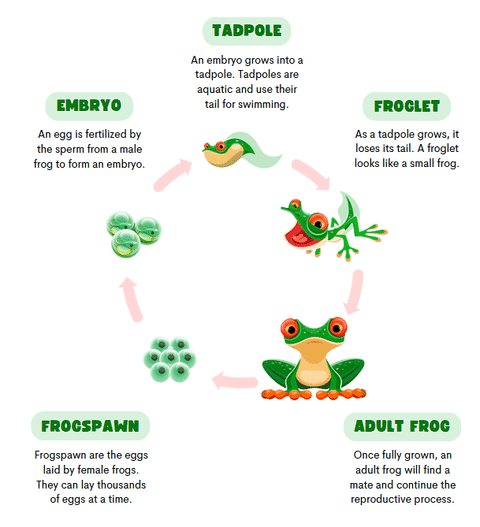 Life Cycle of a Frog
Life Cycle of a Frog
Duration of Each Stage
- Stage I - Spawn (Day 1)
- Stage I - Embryo (Day 7-10)
- Stage II - Tadpole with legs (8-10 weeks)
- Stage III - Froglet (12 weeks)
- Stage IV - Adult frog (14 weeks)
Key Points
- We encounter both living beings and non-living things around us; knowing how they differ is important in biology.
- Living beings can move; while animals move noticeably, plants display subtle movements like phototropism.
- Growth refers to an increase in size and number of cells, influenced by nutrient intake.
- Living beings require food (nutrition) for their growth and development.
- Gas exchange (oxygen and carbon dioxide) is vital for energy production in cells.
- Removing waste products is essential to maintain internal balance and avoid toxicity.
- Living beings respond to changes in their environment for adaptation and protection.
- Reproduction is necessary for the continuation of a species.
- If a living being cannot display any of the aforementioned characteristics, even with all necessary resources (like food, air, and water), it is considered dead.
- Living beings show movement, growth, nutrition, respiration, excretion, response to stimuli, reproduction, and eventually die; lacking any of these traits signifies they are non-living things.
- Each living being experiences various stages throughout its life.
- The germination of seeds relies on the availability of water, air, and appropriate light and/or dark conditions.
|
100 videos|261 docs|49 tests
|
FAQs on Living Creatures: Exploring their Characteristics Chapter Notes - Science Class 6
| 1. What are the essential conditions required for seed germination? |  |
| 2. How do plants exhibit growth and movement? |  |
| 3. What is the life cycle of a plant? |  |
| 4. How does the life cycle of animals differ from that of plants? |  |
| 5. What are the key characteristics of living creatures? |  |



